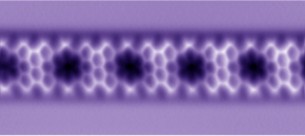Successful Boron-Doping of Graphene Nanoribbon

Graphene nanoribbon under the microscope. (Image: University of Basel)
Graphene is one of the most promising materials for improving electronic devices. The two-dimensional carbon sheet exhibits high electron mobility and accordingly has excellent conductivity. Other than usual semiconductors, the material lacks the so-called band gap, an energy range in a solid where no electron states can exist.
Therefore, it avoids a situation in which the device is electronically switched off. However, in order to fabricate efficient electronic switches from graphene, it is necessary that the material can be switched ”on” and ”off”.
The solution to this problem lies in trimming the graphene sheet to a ribbon-like shape, named graphene nanoribbon (GNR). Thereby it can be altered to have a band gap whose value is dependent on the width of the shape.
Synthesis on Gold Surface
To tune the band gap in order for the graphene nanoribbons to act like a well-established silicon semiconductor, the ribbons are being doped. To that end, the researchers intentionally introduce impurities into pure material for the purpose of modulating its electrical properties.
While nitrogen doping has been realized, boron-doping has remained unexplored. Subsequently, the electronic and chemical properties have stayed unclear thus far.
Prof. Dr. Ernst Meyer and Dr. Shigeki Kawai from the Department of Physics at the University of Basel, assisted by researchers from Japanese and Finnish Universities, have succeeded in synthesizing boron-doped graphene nanoribbons with various widths.
They used an on-surface chemical reaction with a newly synthesized precursor molecule on an atomically clean gold surface. The chemical structures were directly resolved by state-of-the-art atomic force microscopy at low temperature.
Towards a Nitrogen Oxide-Sensor
The doped site of the boron atom was unambiguously confirmed and its doping ratio – the number of boron atoms relative to the total number of atoms within the nanoribbon – lay at 4.8 atomic percent. By dosing nitric oxide gas, the chemical property known as the Lewis acidity could also be confirmed.
The doped nitric oxide gas was highly-selectively adsorbed on the boron site. This measurement indicates that the boron-doped graphene nanoribbon can be used for an ultra-high sensitive gas sensor for nitrogen oxides which are currently a hot topic in the industry as being highly damaging to the environment.
Original Source
S. Kawai, S. Saito, O. Oshima, S. Yamaguchi, A. S. Foster, P. Spiker, and E. Meyer
Atomically controlled substitutional boron-doping of graphene nanoribbons
Nature Communications, 6. 8098 (2015), doi: 10.1038/ncomms9098
Further Information
Professor Ernst Meyer, University of Basel, Department of Physics, Tel. +41 61 267 37 24, email: ernst.meyer@unibas.ch
https://www.unibas.ch/en/News-Events/News/Uni-Research/Succesful-Boron-Doping-of…
Media Contact
All latest news from the category: Physics and Astronomy
This area deals with the fundamental laws and building blocks of nature and how they interact, the properties and the behavior of matter, and research into space and time and their structures.
innovations-report provides in-depth reports and articles on subjects such as astrophysics, laser technologies, nuclear, quantum, particle and solid-state physics, nanotechnologies, planetary research and findings (Mars, Venus) and developments related to the Hubble Telescope.
Newest articles

First-of-its-kind study uses remote sensing to monitor plastic debris in rivers and lakes
Remote sensing creates a cost-effective solution to monitoring plastic pollution. A first-of-its-kind study from researchers at the University of Minnesota Twin Cities shows how remote sensing can help monitor and…

Laser-based artificial neuron mimics nerve cell functions at lightning speed
With a processing speed a billion times faster than nature, chip-based laser neuron could help advance AI tasks such as pattern recognition and sequence prediction. Researchers have developed a laser-based…

Optimising the processing of plastic waste
Just one look in the yellow bin reveals a colourful jumble of different types of plastic. However, the purer and more uniform plastic waste is, the easier it is to…


